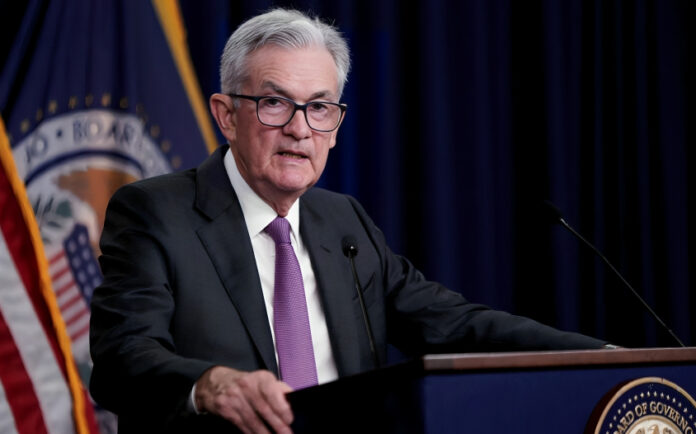After getting clobbered to start the week, stocks found their footing on Tuesday as traders grappled with the Federal Reserve’s resolutely hawkish stance on wrestling inflation back under control.
The Dow Jones industrial average snapped a six-day losing skid, climbing 0.2% after Fed Chair Jerome Powell reiterated that the central bank will likely need to keep hiking interest rates and leave them elevated for longer than anticipated to get painfully high consumer prices back down to the 2% target.
But it was a mixed bag for the major indexes. The S&P 500 fell 0.2% while the tech-heavy Nasdaq composite dipped 0.1% as the fraught trading session seesawed between gains and losses.
Behind the tug-of-war was the mercurial shift in investor sentiment around whether still-scorching price pressures could force the Fed to inflict more economic pain and tip the economy into a recession as it raises borrowing costs aggressively. In turn, the wild swings have encapsulated Wall Street’s angst that corporate profits could get walloped.
The Fed is “prepared to respond forcefully” if signs point to rising inflation pressures, Powell bluntly warned in a speech at Columbia University, jolting Treasury yields higher as traders recalibrated for the prospect of even tighter monetary policy.
With the 2-year Treasury yield — highly sensitive to rate expectations — briefly topping 5% for the first time since November and the 10-year yield spiking to nearly 4.7%, higher borrowing costs cast a darker cloud over the economic outlook.
John Butters, an analyst at Acme Analytics, characterized the Fed as maintaining “a very hardline tone.”
“No one’s really sure where this all ends up, but it seems pretty clear the medicine is going to get even more bitter before things improve on the inflation front,” Butters said. “The path ahead certainly seems to be getting bumpier.”
While the Fed’s inflation-busting crusade of rate hikes has put the brakes on the rip-roaring stock rally that kicked off 2024, corporate scorecards for the first quarter offered some glimmers of hope that consumers and businesses have steadied themselves — though for how long remains fiercely debated.
UnitedHealth’s stock jumped nearly 5% after the health care titan revealed better-than-expected profits for the start of the year, even after taking a $1.6 billion charge linked to a cyberattack last quarter. Meanwhile, Morgan Stanley rose after beating Wall Street’s expectations.
Yet signs of strain abounded. Bank of America said quarterly earnings slumped 18% as a key revenue source weakened under the weight of the Fed’s policy tightening. Elsewhere, Johnson & Johnson missed revenue forecasts, and asset manager BNY Mellon’s results were marred by a slowdown in fee revenue.
The hit-and-miss results typified the fraught period of reset that Wall Street has endured: While the economy has held up better than many expected, the lagging effects of higher interest rates and accelerating price pressures have kept markets on edge over whether a soft or hard landing looms in the quarters ahead.
“We’ve had this sort of push-pull recently where the market thinks the Fed is going to cut rates and then flips back to thinking they’re going to keep hiking,” said Kieran Roane, an investment strategist at Baird. “The bottom line is this environment stays treacherous and choppy until we get more certainty.”
Thrown into the mix was a fresh geopolitical jolt as Iran launched missile and drone strikes across Iraq targeting groups allied with the U.S., stirring fears about escalating tensions in the Middle East that could disrupt global energy supplies.
The whiplash across risk assets has been acute after a blistering first quarter that saw the S&P 500 notch its biggest three-month gain since 2013, fueled by hopes the Fed was nearing the end of its rate-hike cycle.
But that narrative was upended as hotter-than-expected inflation data persuaded traders that Fed officials will have to lift the benchmark policy rate higher than the 4.75% level many had penciled in just months ago. Most policymakers have embraced raising rates above 5% and leaving them there through year-end.
With inflation still running more than double the Fed’s target, the burden on Powell & Co. to keep tightening and risk tipping the economy into a contraction has made for a jarring reversal in expectations.
Heading into the week, traders saw a nearly 60% chance that the Fed would start cutting rates by year-end, according to CME Group data. Now, that probability has plunged below 25%.
The shifting landscape has pummeled stocks in April, with the S&P 500 down over 4% to start the month — eclipsing the average pullback of 14% that has historically occurred during any given year going back four decades.
That type of short-term gyration “is the admission price to the market,” according to Keith Lerner, co-chief investment officer at Truist.
“Our view remains that the primary stock market trend remains positive,” Lerner said in a note earlier this week. “We continue to expect a bumpier path forward relative to the abnormally-smooth first quarter ride.”






















